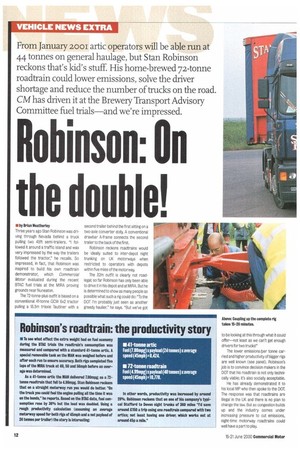Robinson's roadtrain: the productivity story
Page 14

If you've noticed an error in this article please click here to report it so we can fix it.
• To see what effect the extra weight had on fuel economy during the BTAC trials the roacttrain's consumption was measured and compared with a standard 41-tonne artic. k special removable tank on the MAN was weighed before and after each run to ensure accuracy. Both rigs completed five laps of the MIRA track at 40,50 and 56mph before an average was determined.
As a 41-tonne artic the MAN delivered 7.80mpg; as a 72tonne roadtrain that fell to 4.99mpg. Stan Robinson reckons that on a straight motorway run you would do better. "On the track you could feel the engine pulling all the time it was on the bends," he reports. Based on the RUC data, fuel consumption rose by 36% but the load was doubled. Using a rough productivity calculation (assuming an average motorway speed for both rigs of 45mph and a net payload of 24 tonnes per trailer) the story is interesting: In other words, productivity was increased by around 28%. Robinson reckons that on one of his company's typical Stafford to Devon night trunks of 360 miles "I'd save around £150 a trip using one roadtrain compared with two artics; not least having one driver, which works out at around 45p a mile."












































































































